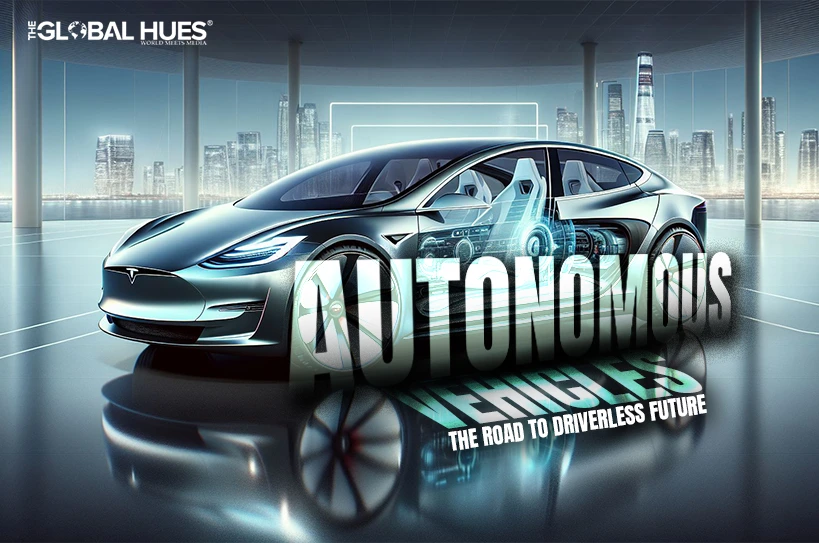No one ever thought Autonomous Vehicles would exist—it’s like experiencing science fiction! However, with many companies such as Tesla or Alphabet by Google, actively developing self-driving cars, it’s like a dream come true. However, there are many fascinating opportunities and difficult problems on the path to a driverless future. The principles of autonomous vehicle technology, the function of artificial intelligence in cars, and what the fast-developing sector of vehicles may contain in the future are discussed here.
What are Autonomous Vehicles?
An autonomous automobile can sense its surroundings and run free from human direction. Unlike conventional vehicles, these observe traffic regulations, negotiate roadways, and understand obstacles using a mix of sensors, cameras, radar, and artificial intelligence (AI). Though not all self-driving cars are really autonomous, autonomous vehicles are sometimes referred to as “self-driving cars.” Only at the greatest degrees of autonomy can a vehicle become totally autonomous—where no human involvement is required at all.
AI’s Involvement in Autonomous Cars
The foundation of autonomous driving technology is artificial intelligence, which lets vehicles make judgments based on split-second decisions people would usually make. Self-driving cars are trained to identify traffic signals, grasp route layouts, and see people and other vehicles using deep learning techniques. Constant processing of vast volumes of data from cameras and sensors by machine learning models lets the car learn from every scenario it comes across.
Fundamentally, artificial intelligence uses sensory data to generate a dynamic map of the vehicle’s surroundings. Detecting everything from a child rushing into the roadway to a sudden blockage, this map helps the automobile to “see” and “understand” the route. Additionally, these judgments have to be made fast and precisely, so the learning and prediction powers of artificial intelligence are significantly valued.
Understanding Vehicle Autonomy Levels
The Society of Automobile Engineers (SAE) defines the steps of the path to complete Vehicle Autonomy Levels (0-5). The following is a brief overview of every level:
Level 0 (No Automation): With no help from any automated technology, the human driver bears all responsibility for vehicle management.
Level 1: Although the human driver is still in full charge, basic driver-assist tools such as lane-keeping help or cruise control are accessible. Under some circumstances, the car can manage steering, acceleration, and braking under Level.
Level 2 (Partial Automation): Under some circumstances, the car can manage steering, acceleration, and braking under the driver must stay engaged.
Level 3 (Conditional Automation): Let the vehicle handle most driving tasks; a human driver must be ready to step in when needed.
Level 4 (High Automation): Although the car may still need human involvement in some situations, it is able to complete autonomy in other specified locations or conditions.
Level 5 (full automation): It requires no human involvement at any one moment as the vehicle is totally autonomous. The automobile can run on this level alone in any driving conditions.
Aiming toward Level 5 autonomy in the next ten years, many businesses are now building cars running at Level 4. However, reaching complete autonomy means conquering major technical and legal obstacles.
The Status of Autonomous Vehicle Technology Right Now
Leading the drive toward an autonomous future are many big Autonomous Vehicle companies like General Motors, Waymo, and Tesla. For example, Tesla’s Autopilot and Full Self-Driving (FSD) systems provide Level 2 automation—that is, when the car helps drive, but the driver must stay involved. Alphabet’s (Google’s parent company) Waymo division has advanced to Level 4, enabling its vehicles to run in designated regions free from human control.
True Level 5 autonomy—where no driver assistance is required under any conditions—remains under development even while technology is growing fast. Even when technology is growing fast, there are several hurdles to implementing AI in Automobiles. Furthermore, rules on autonomous cars differ greatly depending on the area, which increases the complexity of implementation.
Benefits of Independent Vehicles
The move to driverless vehicles might provide several transforming advantages:
Enhanced Safety – Autonomous vehicles, such as cars or trucks, are supposed to reduce human mistakes, which account for about 94% of traffic accidents. Safer roads result from self-driving cars’ ability reliably and faster to recognize and respond to threats than human drivers.
Improved Traffic Flow – AI in automobiles allows AVs to maximize speed, braking, and lane use, hence improving traffic flow and lowering congestion.
Increased Accessibility – Self-driving technology might provide more sense of freedom by helping persons with impairments, older people, and those unable to drive to have more mobility.
Environmental Benefits – Through careful driving and route choice, autonomous cars—especially electric AVs—have the potential to lower emissions and energy use.
Cost Savings – AVs could lower vehicle ownership costs. Additionally, affordable transportation with less need for maintenance makes shared autonomous cars a sensible substitute for private automobile ownership.
However, widespread acceptance will depend on public confidence in autonomous cars.
Future of Transportation
For self-driving automobiles, therefore, what does the future seem to hold? Authorities think we are about to experience a revolution in transportation. Autonomous vehicles may find increasing use in the next few years for certain uses such as ride-sharing, public transportation, and logistics. While AVs might assist in maximizing delivery services in the logistics sector, fleets of autonomous taxis could become standard in metropolitan regions.
Furthermore, the incorporation of 5G networks hasten AV development, facilitating faster and more dependable data transmission across infrastructure, cloud systems, and automobiles. Future autonomous driving depends on this connectivity as it enables cooperative decision-making among vehicles on the road and real-time data exchange.
Conclusion
Autonomous vehicles mark a new age in transportation, one that offers accessibility, efficiency, and safety. Although there are problems to solve, AVs have too many possible advantages as well. Self-driving cars and trucks will affect every element of our mobility, from changing urban design to lowering accidents. The journey could be just as transforming as the destination as we get nearer an autonomous future.
Ultimately, whether it’s for environmental sustainability, safety, or convenience, the road to autonomy is one we are only starting to travel.



